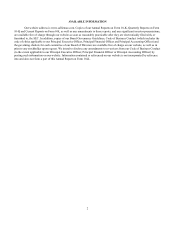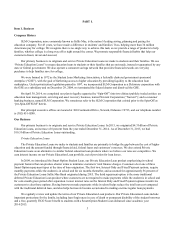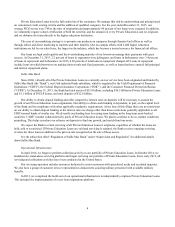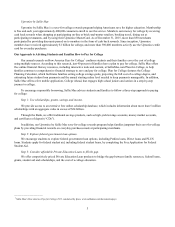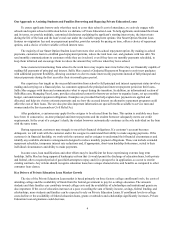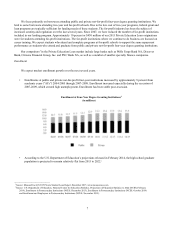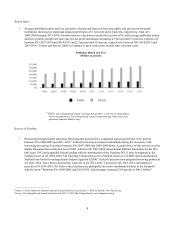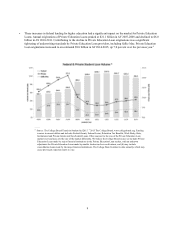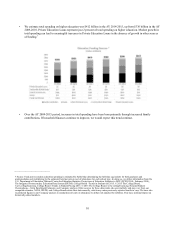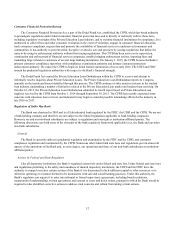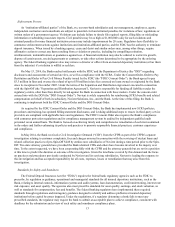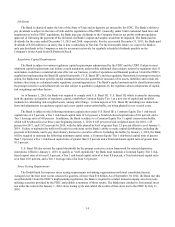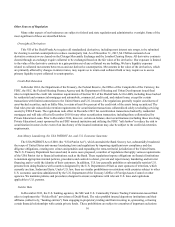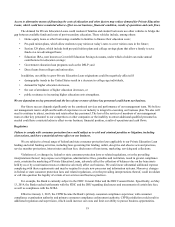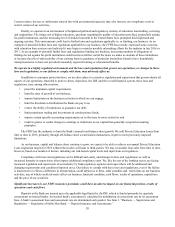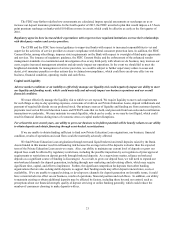Sallie Mae 2015 Annual Report Download - page 14
Download and view the complete annual report
Please find page 14 of the 2015 Sallie Mae annual report below. You can navigate through the pages in the report by either clicking on the pages listed below, or by using the keyword search tool below to find specific information within the annual report.12
Consumer Financial Protection Bureau
The Consumer Financial Protection Act, a part of the Dodd-Frank Act, established the CFPB, which has broad authority
to promulgate regulations under federal consumer financial protection laws and to directly or indirectly enforce those laws,
including regulatory oversight of the Private Education Loan industry, and to examine financial institutions for compliance. It is
authorized to collect fines and order consumer restitution in the event of violations, engage in consumer financial education,
track consumer complaints, request data and promote the availability of financial services to underserved consumers and
communities. It has authority to prevent unfair, deceptive or abusive acts and practices by issuing regulations that define the
same or by using its enforcement authority without first issuing regulations. The CFPB has been active in its supervision,
examination and enforcement of financial services companies, notably bringing enforcement actions, imposing fines and
mandating large refunds to customers of several large banking institutions. On January 1, 2015, the CFPB became the Bank’s
primary consumer compliance supervisor with compliance examination authority and primary consumer protection
enforcement authority. We expect the CFPB to begin its initial formal examination of us in early 2016. The UDFI and FDIC
remain the prudential regulatory authorities with respect to the Bank’s financial strength.
The Dodd-Frank Act created the Private Education Loan Ombudsman within the CFPB to receive and attempt to
informally resolve inquiries about Private Education Loans. The Private Education Loan Ombudsman reports to Congress
annually on the trends and issues identified through this process. The CFPB continues to take an active interest in the student
loan industry, undertaking a number of initiatives related to the Private Education Loan market and student loan servicing. On
October 16, 2015, the Private Education Loan Ombudsman submitted its fourth report based on Private Education Loan
inquiries received by the CFPB from October 1, 2014 through September 30, 2015. The CFPB has recently expressed some
concerns with education loan servicers and indicated it may begin to consider possible rulemaking efforts for the industry in
late 2016 or 2017.
Regulation of Sallie Mae Bank
The Bank was chartered in 2005 and is a Utah industrial bank regulated by the FDIC, the UDFI and the CFPB. We are not
a bank holding company and therefore are not subject to the federal regulations applicable to bank holding companies.
However, we and our non-bank subsidiaries are subject to regulation and oversight as institution-affiliated parties. The
following discussion sets forth some of the elements of the bank regulatory framework applicable to us, the Bank and our other
non-bank subsidiaries.
General
The Bank is currently subject to prudential regulation and examination by the FDIC and the UDFI, and consumer
compliance regulation and examination by the CFPB. Numerous other federal and state laws and regulations govern almost all
aspects of the operations of the Bank and, to some degree, our operations and those of our non-bank subsidiaries as institution-
affiliated parties.
Actions by Federal and State Regulators
Like all depository institutions, the Bank is regulated extensively under federal and state law. Under federal and state laws
and regulations pertaining to the safety and soundness of insured depository institutions, the UDFI and the FDIC have the
authority to compel or restrict certain actions of the Bank if it is determined to lack sufficient capital or other resources, or is
otherwise operating in a manner deemed to be inconsistent with safe and sound banking practices. Under this authority, the
Bank’s regulators can require it to enter into informal or formal supervisory agreements, including board resolutions,
memoranda of understanding, written agreements and consent or cease and desist orders, pursuant to which the Bank would be
required to take identified corrective actions to address cited concerns and refrain from taking certain actions.


